Last year, Merida revitalized its line up of trail and enduro bikes with the launch of the 2023 Merida ONE-SIXTY and ONE-FORTY, the former of which we review here in the 6000 Model which retails at £4,600 (€5,760). While the two are built around the same front and rear triangles, different shock and fork specs switch their intention between trail and enduro, respectively.
As the name suggests, the ONE-SIXTY supports the most rear wheel travel, coming in at 162mm when rolling on a 29″ wheelset, and 171mm when set up in a mixed wheel configuration; i.e. a 29″ front wheel and a 27.5″ rear wheel. Indeed, all 5 frame sizes can switch between those two configurations. The Extra Short, Short and Mid sizes are shipped 29″/27.5″, while the Long and Extra Long sizes are shipped with a complete 29″ wheelset.
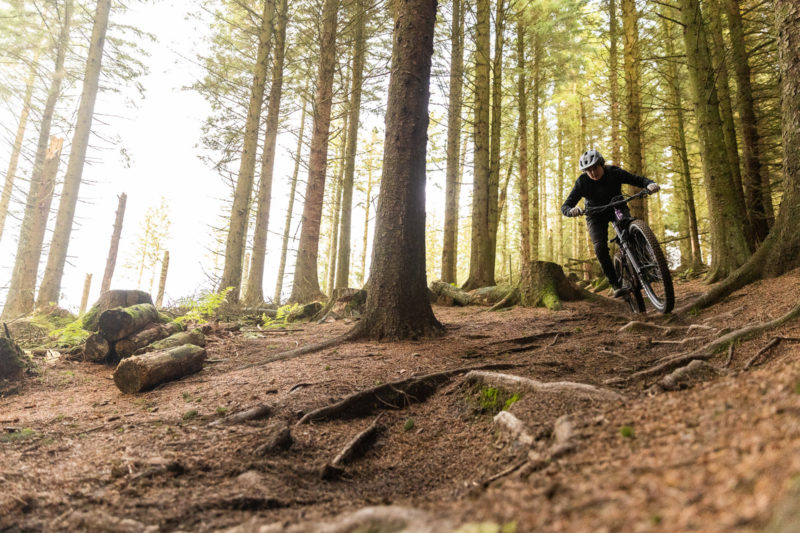
We were pretty excited about this bike when it launched. Save for the headset-routed cable routing, everything about it seemed to be right on the money; the kinematic’s leverage curve is tailored to each frame size, the dropper seat post is infinitely adjustable between 30mm and 230mm, there is a frame storage compartment, plenty of room for a decent size water bottle inside the front triangle, and the geometry is bang-up-to-date.
And, the price isn’t silly.
2023 Merida ONE-SIXTY – The Tech Details
The 2023 Merida ONE-SIXTY delivers its rear wheel travel via a linkage-driven single-pivot design reliant upon a number of degrees of flex in the seatstays. Indeed, this is a more sophisticated version of the P-FLEX system seen on Merida’s lightweight NINETY-SIX cross-country bike. As such, the bike has a one-piece swingarm, and there are eight pivots to maintain.
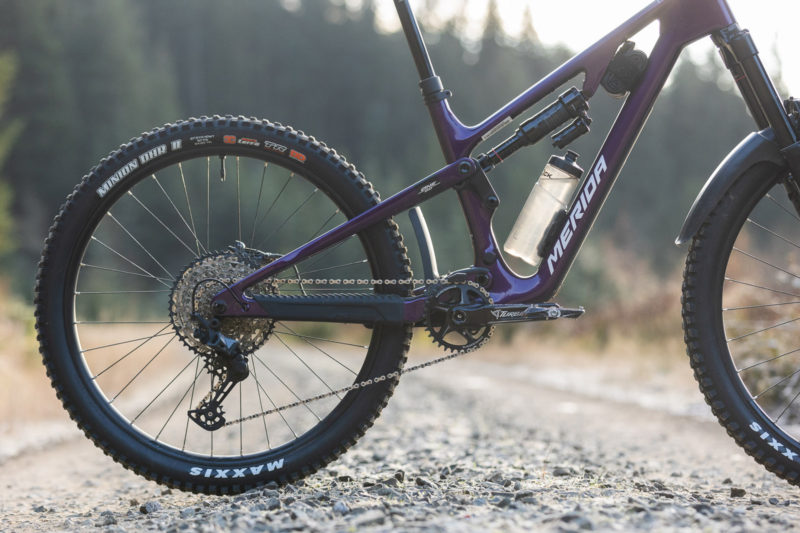
Merida has moved to the flex-pivot arrangement for the same reasons many other brands have over the last few years; this method of delivering rear wheel travel does away with the bearings and hardware of a traditional pivot, replacing it with flexible seat stays. Thus, the frame can be lighter, and with fewer pivots to monitor for wear, long-term ownership could be considered comparatively easier and cheaper.
With weight being high on the list of priorities for XC and Downcountry bikes, use of a flex-pivot is common. However, it is still fairly unusual to see its implementation on bikes running more than 140mm of rear wheel travel. Here on the ONE-SIXTY, it’s compressing a 230mm x 65mm shock to deliver 162mm or 171mm, dependent on the rear wheel size.
You may question how strong the frame can be given the inherent flex in the seat stays, especially when you remember there is an aluminum frame option in addition to the carbon frame tested here. In this regard, Merida went above and beyond; both frames meet the Category 5 ASTM requirements, and are thus approved for use in “extreme jumping or downhill grades on rough trails at speeds in excess of 40 km/h (25 mph)”. You may have thought that a given for a bike with this much travel, but it may surprise you to learn that a number of enduro bikes are only approved to Category 4; the 2022 Canyon Strive and SCOR 4060 LT being two such examples. You can learn more about this classification system at astm.org.
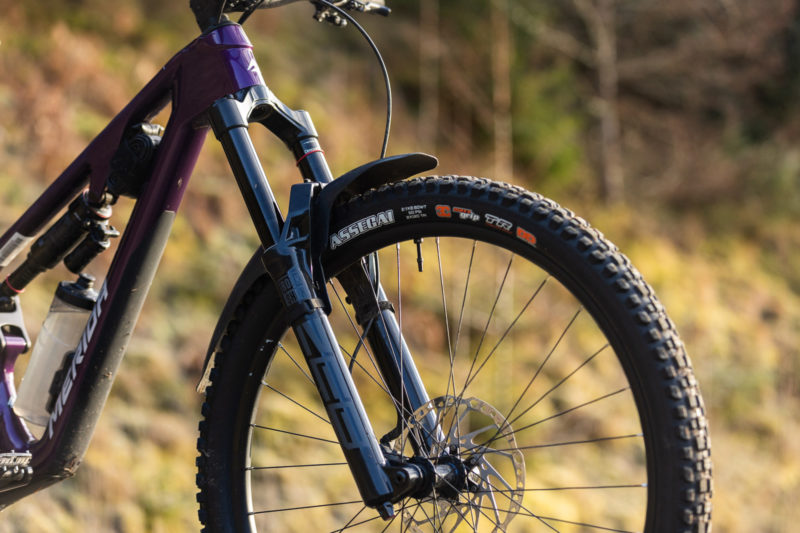
ONE-SIXTY Geometry & Kinematic
The Merida ONE-SIXTY has a relatively progressive set of geometry figures; a 79° seat tube angle is paired with a 64° head angle. Seat tubes aren’t the shortest we’ve ever seen, but given that all of the bikes benefit from the Merida Team TR Dropper seat post which is infinitely adjustable between 30mm and 200mm, that’s sort of a moot point. It gives riders freedom optimize their bum-to-saddle clearance to within a single millimeter.
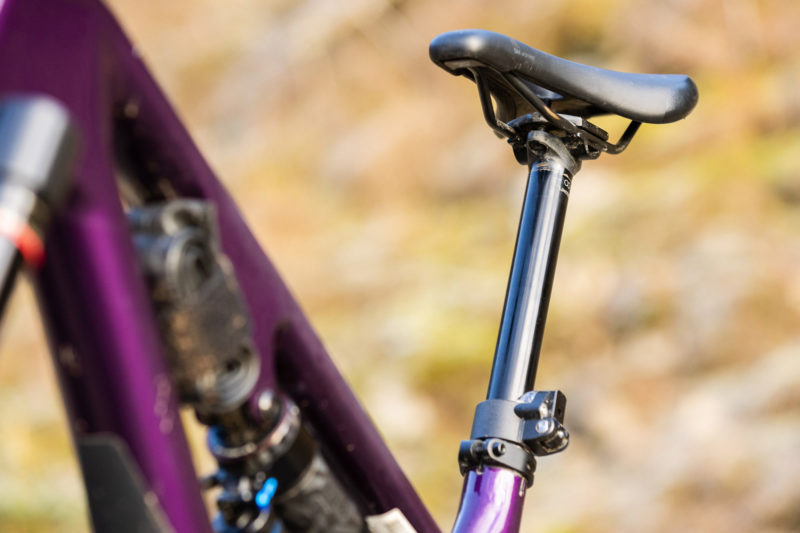
Complementing that are some generous reach figures, stretching from 415mm on the X-Short, up to 525mm on the X-Long. It was Merida’s intention to allow riders to choose their frame size based on how roomy they want the cockpit to feel without too much concern for standover height. The recommendation is that, if you find you are between sizes, you should go for the shorter option if you want a more agile, snappier ride feel, or the longer option if you’re looking to prioritize stability.
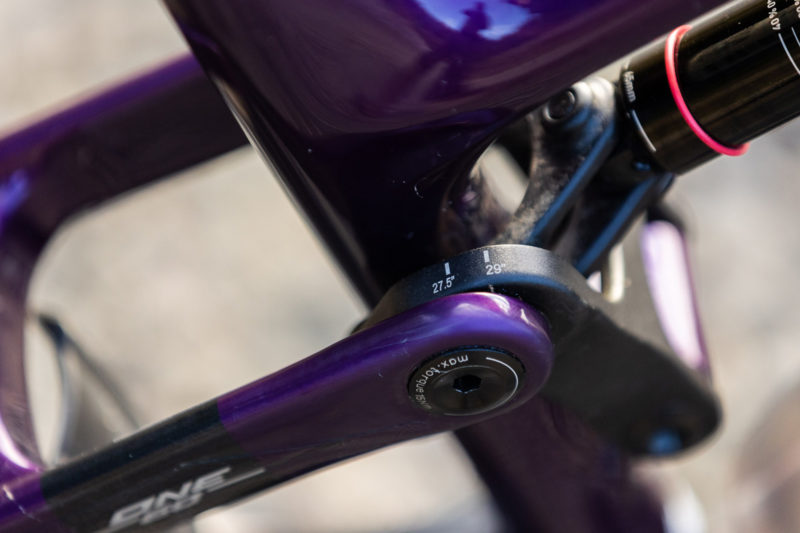
Short head tubes make for low stack heights, giving riders the freedom to play around with a wide range of ride heights. The steerer tube on our test bike was mistakenly cut a little too short; production bikes will see longer steerer tubes and more spacers (25mm) underneath the stem than what can be seen here (15mm).
In its mixed-wheel configuration, the BB is a little on the high side with a 7mm drop, but a 27.5mm drop in 29″/29″ is fairly standard.
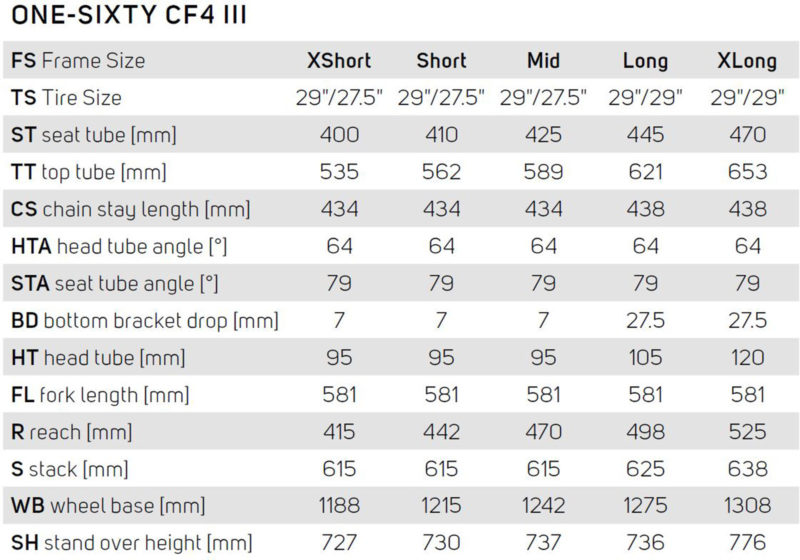
While Merida did not go for a proportional approach to chainstay length, they did opt to tailor the leverage curve of each frame size through subtle differences in the length of the top tube shock mount tab, and thus the position the shock sits within the front triangle.

Progression, as measured from sag to 95% of the travel, comes in at 6%, 7.6%, 9.3%, 12.7% and 14.1% on the X-Short, Short, Mid, Long and X-Long frames, respectively. So, the larger frames see more progression, in line with the likelihood they will be ridden by heavier riders requiring more support. In all cases, the leverage curve becomes regressive toward bottom-out to help riders squeeze every last millimeter out of the stroke.
While all five models of the Merida ONE-SIXTY come with air shocks, the brand do say the leverage curve can work well with coil shocks. It’s important to note here that the linkage makes use of a clevis link to drive the shock, but it is relatively short at just 50mm. Merida say they have been running coil shocks on the ONE-SIXTY and have thus far found no issues there. However, they do warn against use of the Fox DHX2 as it has a narrower damper shaft that could be more vulnerable to side-loading issues.
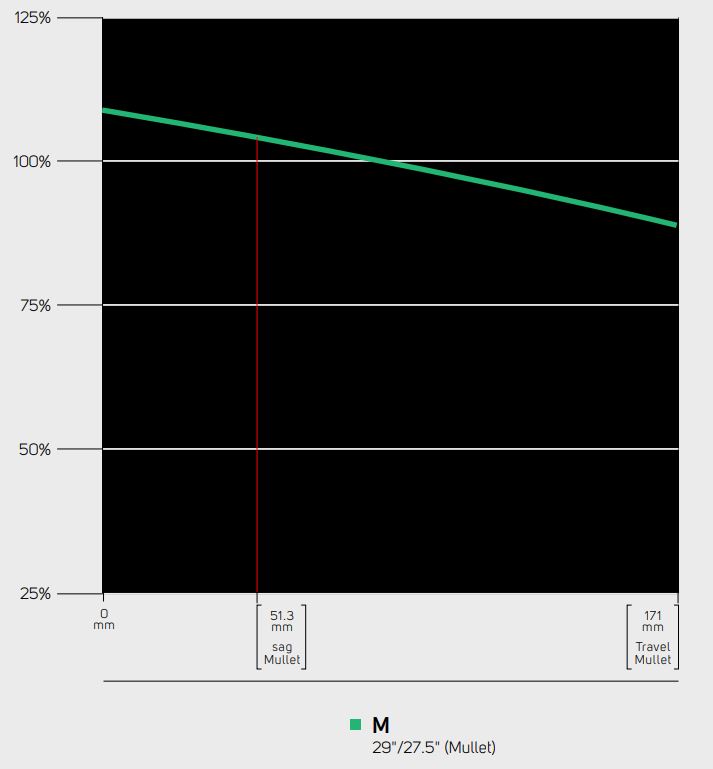
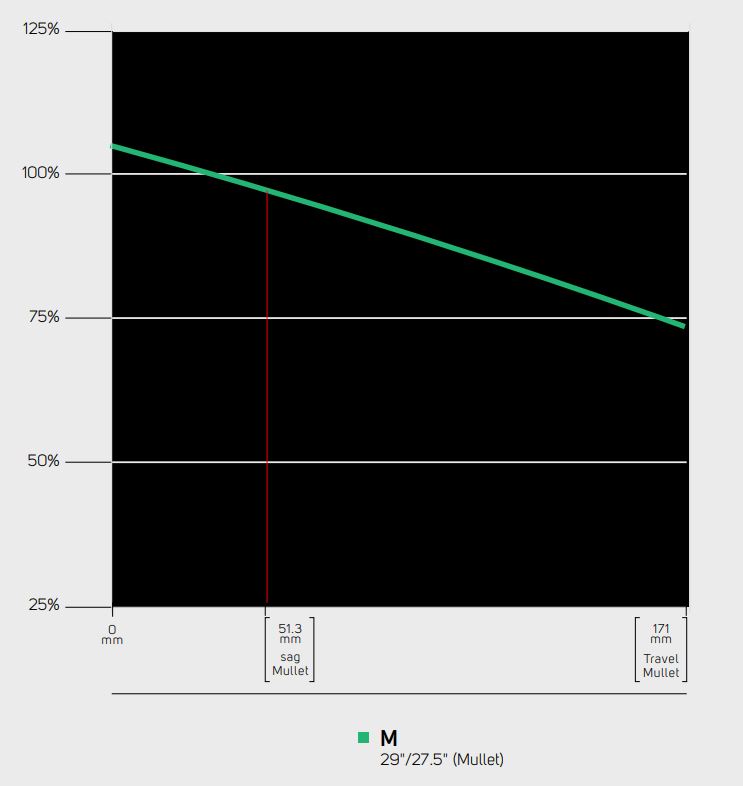
Anti-squat in the climbing gears is just north of 100% at the sag point, suggesting the shock would extend slightly under pedal-induced accelerations. It then hits 100% a fair chunk deeper into its travel. Given that you’re likely to be pedaling up something steep in the 51T sprocket of the cassette, I guess it makes a lot of sense to optimize the linkage layout to be impervious to pedal-induced accelerations at a point in the travel that’s a little deeper than sag.
Anti-rise dips below 100% at sag, indicating the suspension’s tendency to extend, rather than compress, when you yank on the rear brake. Merida says this gradual decrease in anti-rise leads to more active suspension and increased traction while slowing down on rough terrain or after big drops.
Merida ONE-SIXTY Accoutrements
Indeed, the Merida ONE-SIXTY boasts a large number of additional items of equipment that have broad appeal. Starting at the rear, we see a multi-tool held inside the rear axle via a magnet. It is home to 4/5/6 mm allen keys, necessary for tightening the pivot bolts. Then, we have an unusual-looking rear brake mount with a finned design, meant to improve heat dissipation. Next up is the stock bolt-on rear fender that does a good job of preventing the “loam shelf”. There is a longer bolt-on rear fender that can be purchased separately.
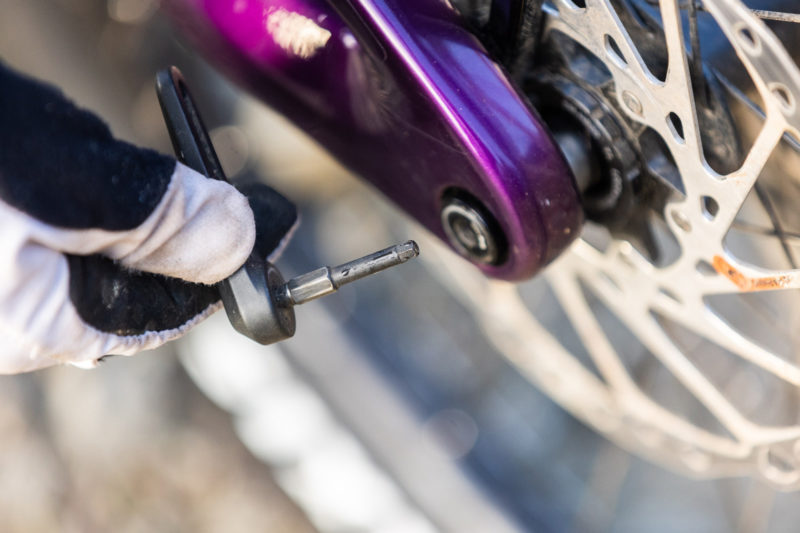
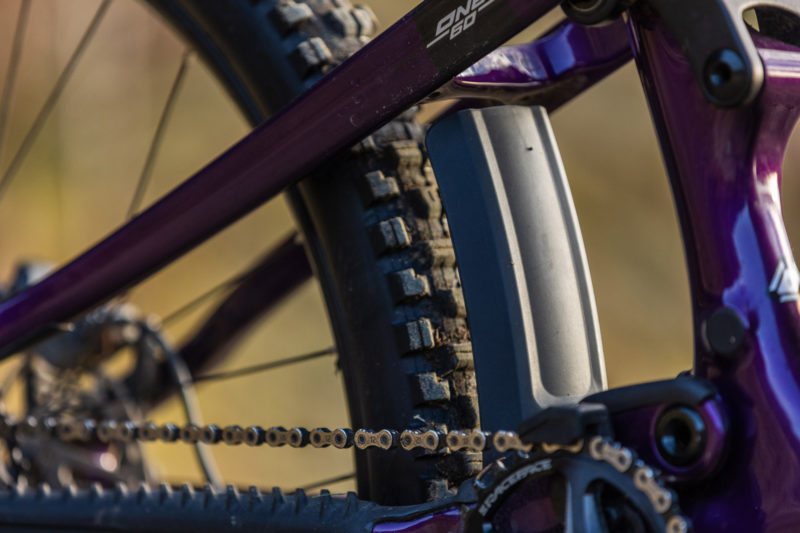
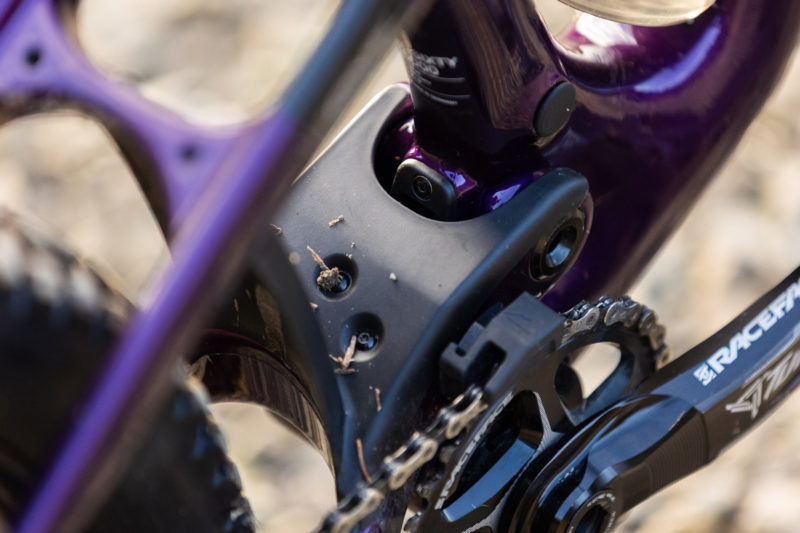
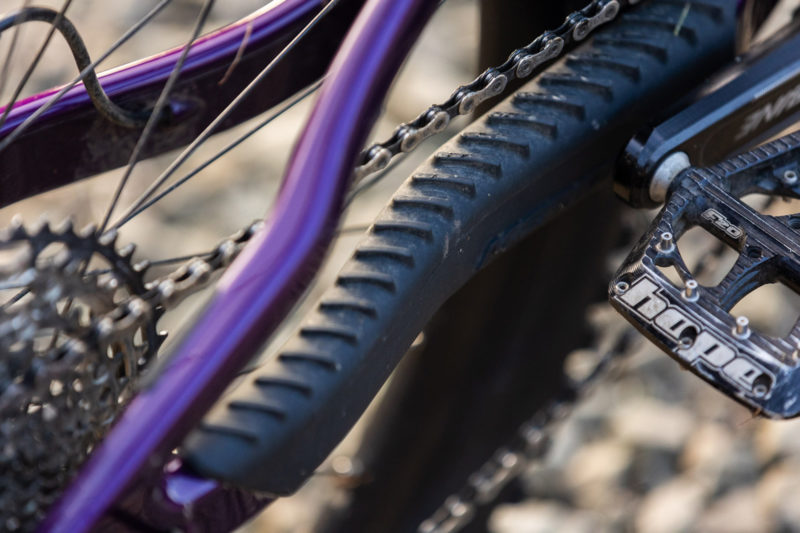
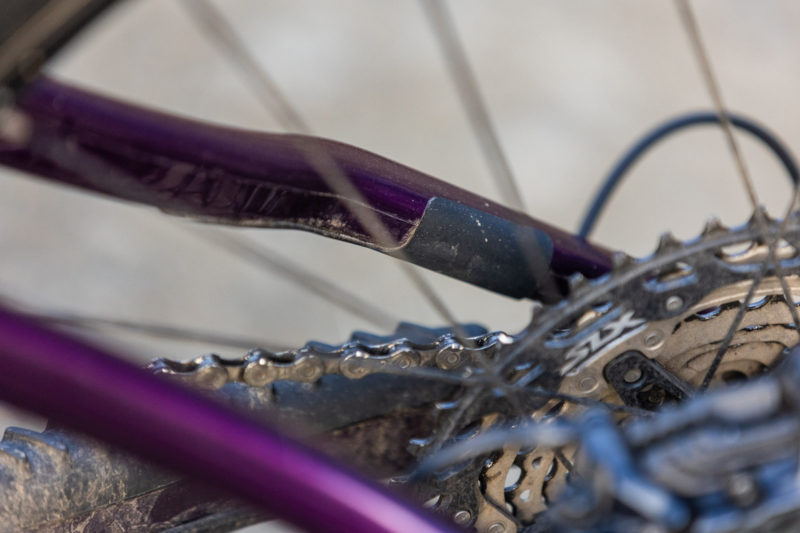
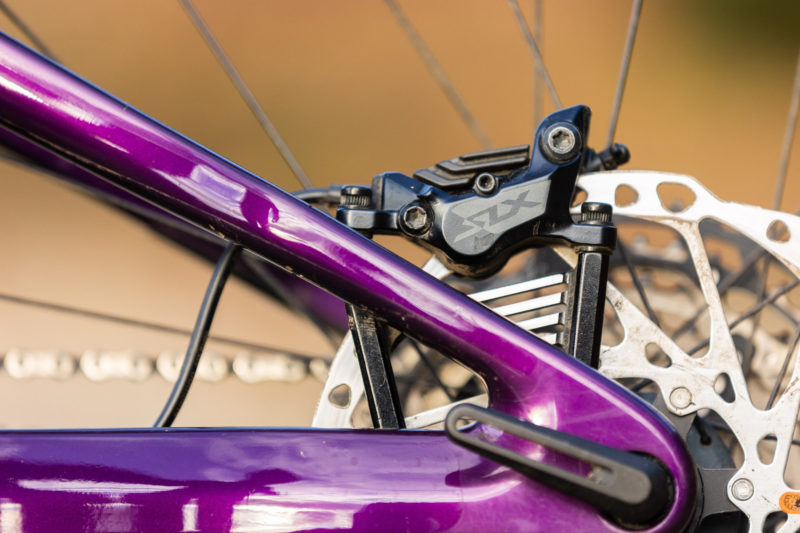
A ribbed chainstay protector runs its full length helping to keep the bike quiet; the drive-side seat stay also gets a wee bit of protection from chain slap, too. Not shown is a multi-tool hidden underneath the Merida Expert SL saddle that is home to 2/2.5/3/4/5/6/8mm allen keys, T10/15/25, as well as a flat-head screwdriver.
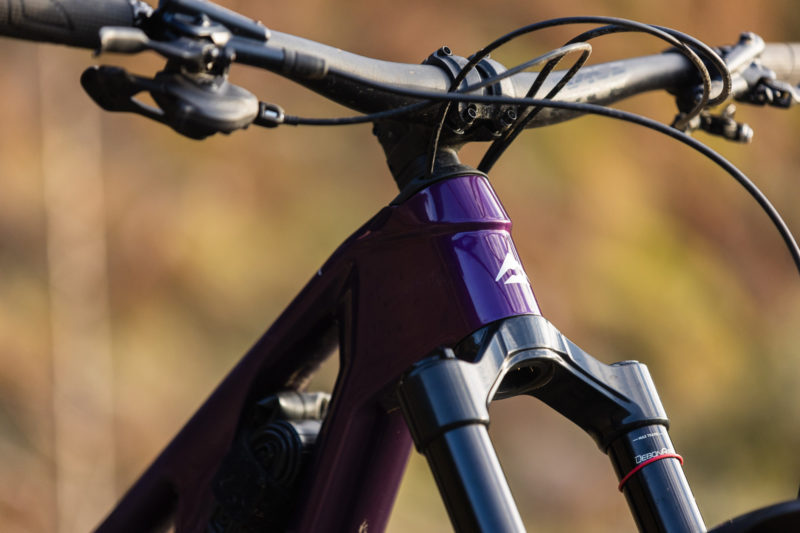
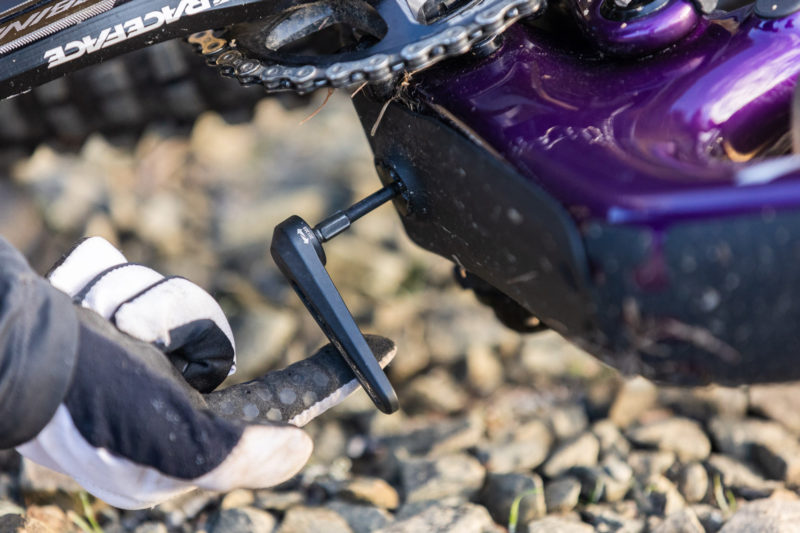
Moving to the front triangle, the carbon ONE-SIXTY gets a recess in the downtube for flush fitment of a FIDLOCK water bottle; all sizes can take at least a 600ml bottle. Then, underneath the top tube you’ll find a bracket convenient for storage of an innertube. At the headtube, you’ll see the cables run through the headset which, honestly, we aren’t super stoked on. That said, they are fully guided through tubes thereafter. On the alloy version, the cables are guided via foam inserts.
Last but not least, the downtube has a storage compartment. The stock bikes are shipped with this empty, but there will be a tool roll available to purchase separately (price and contents of which we await). Our test bike was without this tool roll, so we have no comment on that.
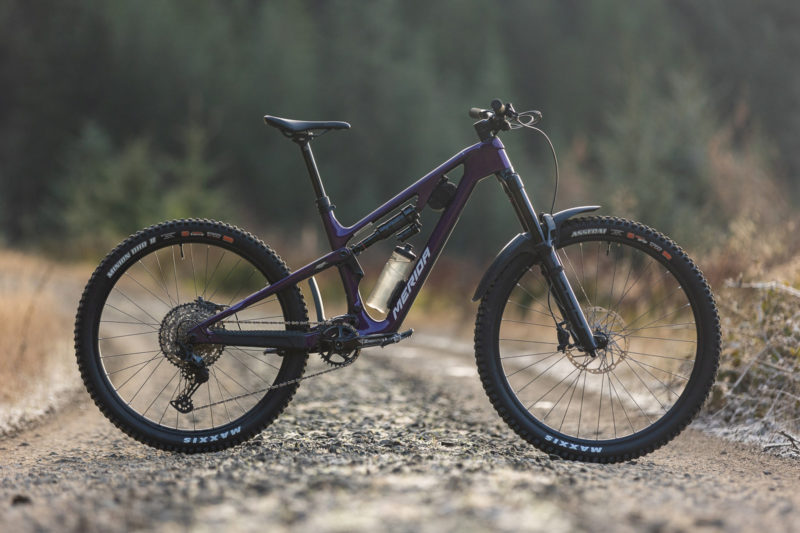
2023 Merida ONE-SIXTY 6000 Review
At 163cm tall, I am a good candidate for either the X-Short or Short Merida ONE-SIXTY. In determining the appropriate size for a given rider, Merida ask not only for their height, but also their leg length and arm length. My arms are slightly longer than those of your average 163cm tall individual. Because of that, Merida recommend the Short over the X-Short. Were my arms 2 cm shorter, their recommendation would be the X-Short.
So, I tested the Short ONE-SIXTY with a 442mm reach, 410mm seat tube length, and in the mixed-wheel configuration in which it is shipped. That gives it an effective 434mm rear-center length. For an appropriate fit, I switched out the stock 780mm bar for a 740mm RaceFace equivalent. I also switched out the Merida saddle for my preferred Ergon Women’s SMC.
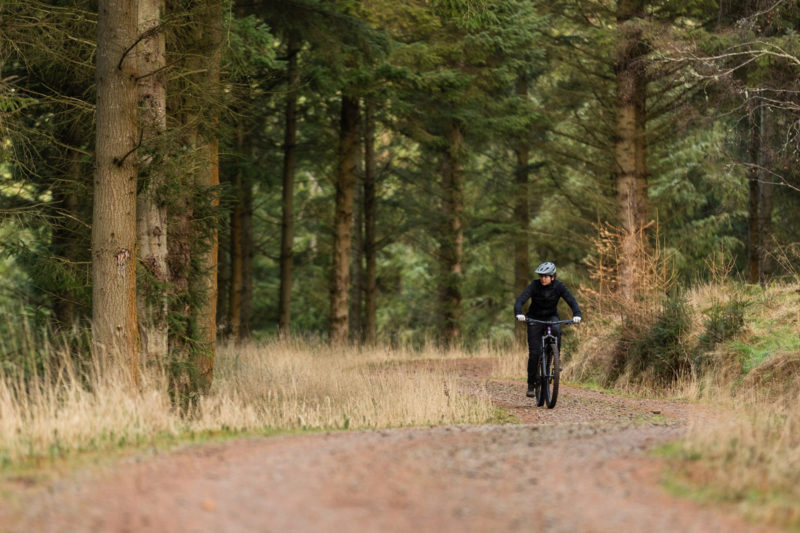
2023 Merida ONE-SIXTY 6000 Build Components
- Frame Size: Short
- Wheel Size: 29″ Front, 27.5″ Rear
- Fork: RockShox ZEB Select, 170mm travel, 44mm offset
- Rear Wheel Travel: 171mm
- Shock: RockShox Super Deluxe Select+, DebonAir Progressive
- Drivetrain: Shimano SLX 12 Speed w/ 32T Race Face Turbine Crankset
- Brakes: Shimano SLX 4 Piston
- Wheels: Merida Expert TR with Shimano SLX Hubs
- Tires: Front – Maxxis Assegai 29″ x 2.5″, DD MaxxGrip, Rear – Maxxis Minion DHRII 27.5″ x 2.4″, DD MaxxTerra
- Handlebar: Merida Team TR Alloy 780mm – XS/S 18mm rise, M/L/XL 25mm rise
- Seat Post: Merida Team TR
- Saddle: Merida Expert SL with Multi-Tool
- Actual Weight: 15.51 kg ~ 34 lbs in Short (without pedals)
- Price: £4,600 (€5,760)
I rode the ONE-SIXTY at 30% sag. The RockShox Super Deluxe Select+ Shock offers fine tuning of the rebound damping, while a two-position lever switches the compression damping between Open and Threshold. The tune of the shock is the exact same for each frame size; that’s the Light Linear Rebound and L1 Compression tunes. The shock has the DebonAir Progressive air spring, with one token in the positive chamber and 0 in the negative.
I ran the RockShox ZEB Select Fork at the manufacturer’s recommendation of 42 PSI (for a 60 kg rider) with the compression damping fully open and the rebound at 15 clicks from closed. It took some time to dial in, and I did remove the fork’s only volume spacer in an attempt to get more travel out of it. Some diving sensations on steep corners led me to add one click of compression damping (of a possible 5).

My first ride aboard the Merida ONE-SIXTY was on the red-graded trail center tracks of Glentress where I was, as you might imagine, rather over-biked. It did, however, give me a good understanding of how the bike performs while climbing fire roads and steep, technical singletrack. The answer is, very well. The 79° seat tube angle puts its rider in a dominating position over the bottom bracket, so I felt no need to slam the saddle forward on its rails.
The bike has a neutral pedaling character, and feels reasonably efficient in spite of its MaxxGrip front tire. While suspension movement isn’t entirely absent, it is so minimal that I never really felt the need to reach down for the shock’s threshold lever while climbing. In the context of other experiences, I’d say the ONE-SIXTY offers up a more neutral pedaling platform than the Vitus Sommet 297 (another mixed-wheel enduro bike with 170mm travel), but isn’t quite as efficient as the SCOR 4060 LT which was really quite impressive in this department.
In the seated pedalling position, I had no qualms with the fit of the bike. It felt a little more upright and leisurely than some bikes in this category, likely thanks to that 79° SA and the 20mm rise bar.
Heading back down the hill, I noted the Merida ONE-SIXTY has great potential to be a very quiet bike, a potential that is maximized upon removal of the axle-housed tool. While it is nice to have the allen keys within easy reach, the tool does rattle around inside its magnetized home. I stuck it in my hip pack.

Venturing onto the hand-cut trails of the valley, the bike was in its element. Scuttling down my go-to test tracks, I was quickly able to find good pace, a great indication that the setup was well-balanced. After playing around with bar-roll for a bit, I managed to get this bike performing really, really well.
It has a distinct ride quality that is somehow very reassuring. The rear end is not the most supple by any means, and could even be descried as a little too supportive on the odd occasion, if such a thing exists. I should point out that I say that in the context of having spent a month riding the Hope HB.916 prior to hoping on the Merida. The ONE-SIXTY’s plentiful mid-stroke support made the bike feel very positive in its feedback, like its constantly telling you, “you got this”, or “i’ve got your back”. It provides a secure platform to push against through the apex of turns when you’re really pumping down through the bike to demand grip from the tires.
The ONE-SIXTY holds its own through rock-strewn chunder-like sections where you kind of just need to stand on the bike and let the suspension do its thing. It rewards the rider’s trust in those situations and is relatively composed. It’s not quite magic-carpet levels of comfort, though, and that was evident on some of the longer 7-8 minute runs. Given that I weight just 60 kg in full riding kit, it’s not outwith the realms of possibility that the shock at least is a little over-damped. While the bike’s leverage curve is size-adjusted, the damping is not.
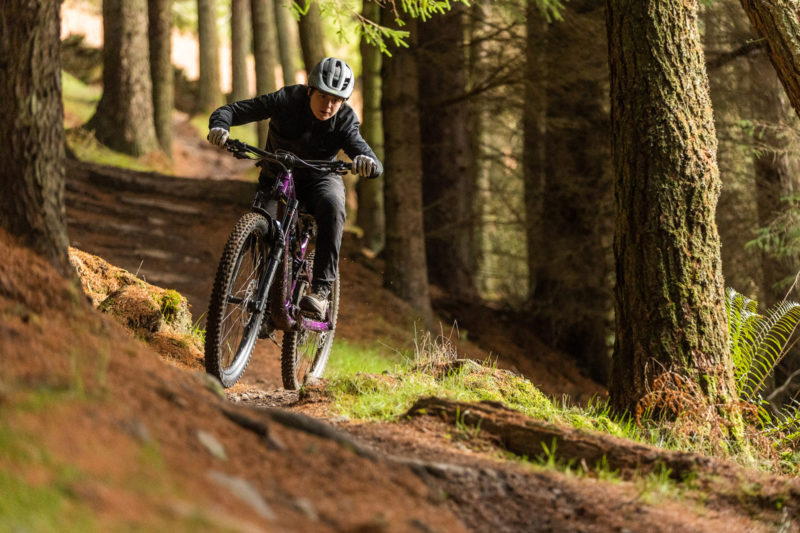
Under braking, the ONE-SIXTY seems to sit high in its travel. I didn’t measure my actual Center of Gravity height on this bike but, given that I could ride the X-Short or the Short, I’d hazard a guess it is slightly lower than the 640mm CoG the Short frame’s suspension kinematic is optimized around. When I think that through, it comes as no real surprise that the bike feels tall under braking. And, i’m not suggesting that’s a bad thing, but it did take a little getting used to on the first few runs, forcing me to drop the heels more to position my weight lower in the bike.
Despite that sensation, the rear-end tracked very well through the rough stuff and my feet were consistently planted where they should be – on the pedals. Honestly, that’s not always the case. Flat pedals always uncover a mis-behaving rear-end, but in this case, i’m pleased to report nothing but great traction that could really be relied upon. While the shock may have been extending a little under braking, the suspension was clearly still able to manage bumps and holes to keep its rider feeling in control.
The mid-stroke support proved useful for accessing bonus lines; you know, the ones where you have to pull tight out of a corner to enter the next early, and as high as possible. The bike’s long-ish reach of 442mm (for me) did limit its playfulness in certain situations, though, and I was mostly just happy to ride with commitment to the often rougher main lines. On steep, fall-line trails, I was a happy rider with the 64° head tube angle showing me plenty of front tire to steer through some tight turns.
In bigger compressions, the Merida didn’t give up its 171mm travel very easily. On most rides, I found I was missing out on 1-2mm stroke, and on only one occasion did I see that the o-ring had been pushed to the full 65mm. That said, I never actually felt it bottom out while I was riding, testament to the quality of the shock’s hydraulic bottom-out control.
To be fair, while I do applaud Merida for investing in quality, fit-for-purpose tires on the ONE-SIXTY, the DoubleDown front tire is probably overkill for me. If it were my bike, i’d switch that out for a more supple EXO+, or even a Continental Kryptotal Enduro tire which has become a favorite of mine over the last 8 months. I’d probably also shove a CushCore Pro insert in the rear and drop the PSI for added comfort.
While I would happily race this bike on the UK enduro circuit for a season, I am curious as to how it would ride with a RockShox Super Deluxe Coil Shock. I’d also be interested to find out how much a custom damper tune on this air shock would improve ride comfort.
2023 Merida ONE-SIXTY Pros
- Reassuring, responsive ride-feel with plentiful positive feedback
- Easy to ride with good pace
- Packed full of useful frame features
- Enduro race-worthy spec
2023 Merida ONE-SIXTY Cons
- Over-damped for the lighter rider
- Cables are routed through the headset
Pricing & Availability
At £4,600 (€5,760), the 2023 Merida ONE-SIXTY 6000 isn’t able to compete with the direct-to-consumer brands such as Canyon and YT, but you’ll be hard-pushed to find a Category 5 ASTM Certified carbon enduro bike packing as many useful features as this one. It’s worth pointing out here that this complete bike costs only £125 more than a Trek Slash C frameset. That said, while Trek offer a lifetime warranty on that frame, Merida can only offer a 5-Year warranty on the ONE-SIXTY.
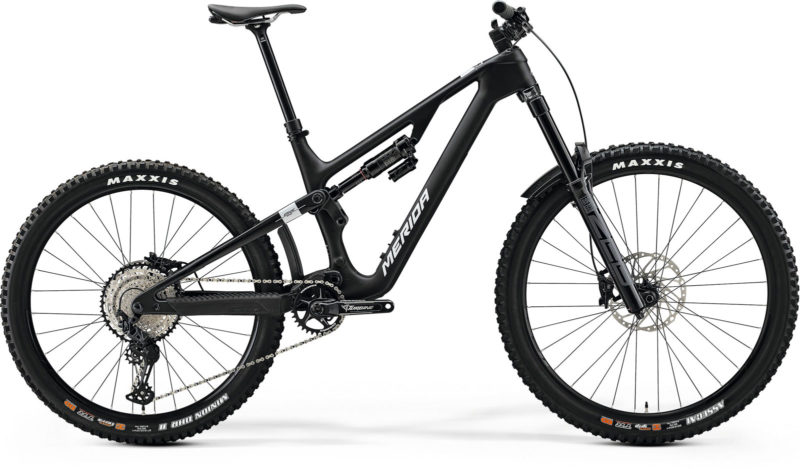
While it is never going to super easy spend to spend £4,600, it does fetch you a wheel size-adjustable bike of a reasonable weight with appropriate build components; a bike that is ready to go racing from the off. I believe the Merida ONE-SIXTY would be a great bike for the vast majority of enduro riders, requiring no obvious and immediately required component changes. That’s to be applauded.
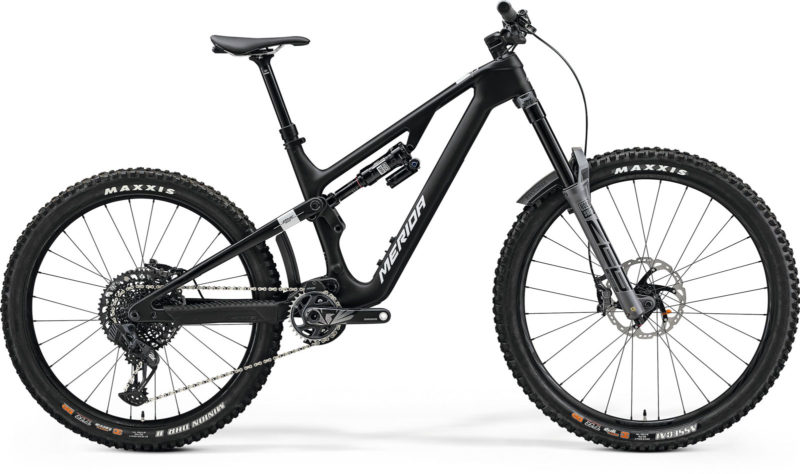
There’s quite a large hike in price moving from the 2023 Merida ONE-SIXTY 6000 reviewed here to the ONE-SIXTY 8000 model (above) which retails at £6,600. Component upgrades are significant, though; in order of importance, it fetches you a RockShox Super Deluxe Ultimate Shock and ZEB Ultimate Fork, a SRAM GX Eagle AXS Drivetrain with X1 Carbon Cranks (if you’re into that), a Race Face Turbine R30 Wheelset and Shimano XT Brakes. For more info on pricing and specification for the complete ONE-SIXTY and ONE-FORTY range, head to the Merida Bikes website.

